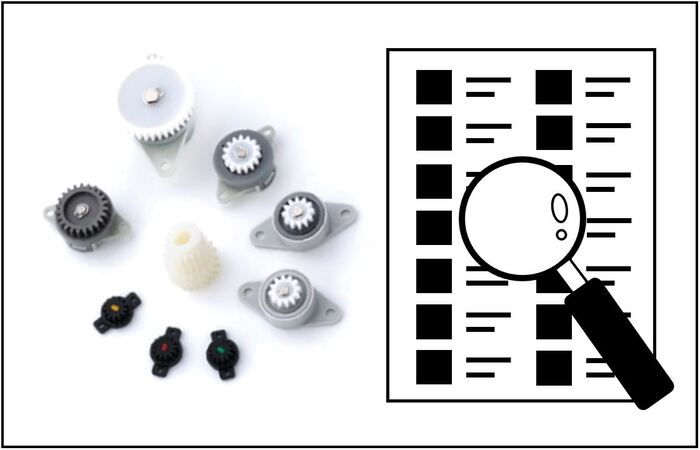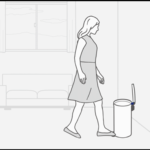
Rotary dampers work by rotating their shaft and generating the viscous resistance of oil. Therefore, when lids are equipped with rotary dampers, any lids can be closed slowly with any desired motion.
Rotary dampers can be recommended for those who want to prevent such problems as loud noises and finger slamming that may occur when lids are closed suddenly with strong force.
You may already know that rotary dampers can move lids slowly, but many of you may not yet be familiar with how to use rotary dampers or where to install them. And if rotary dampers are mounted on lids, how do lids move, and in what situations are they useful? In this issue, we will introduce how to install rotary dampers, how they work, and their main usage.
Contents
How to install rotary dampers

Basically, rotary dampers are mounted at the center of the rotation of an object to be moved. The housing, which is the main body of a rotary damper, is mounted on the fixed side, and the shaft of a rotary damper is mounted on the movable side such as lids.
When you use a lid equipped with rotary dampers, you have to pay attention to the angle limit. If lids are moved beyond the angle limit, the rotary dampers may break, the lids may close early without the rotary damper effect, or oil leakage may occur.
Rotary dampers exert their damping effect in the CW/CCW directions, respectively, as seen from the shaft, so the correct rotary damper should be installed and used in the direction in which the lid is closed. In the case of the lid shown in the picture here, an A type rotary damper rotating in the CW direction is installed on the front side, and a B type rotary damper rotating in the CCW direction is installed on the back side. If a rotary damper of 0.10 N⋅m is installed in the CW direction and a rotary damper of 0.10 N⋅m in the CCW direction as well, the torque value applied to the lid will be 0.20 N⋅m. If a rotary damper of 0.05 N⋅m in the CW direction and a rotary damper of 0.10 N⋅m in the CCW direction are installed, the torque applied to the lid will be 0.15 N⋅m. If rotary dampers of different torque values are installed on both sides, the lid will be twisted. Therefore, the torque values of the left and right rotary dampers must be the same.
Also, if rotary dampers are used beyond their range of motion, they will break off and cease to function as rotary dampers. When rotary dampers break, they are often broken inside the shaft. When rotary dampers are moved, the failure is immediately obvious because the damper is not working. You should use rotary dampers in accordance with the movable range determined for each rotary dampers and the operation angle of lids.
How rotary dampers work
We share the gif animation of a lid equipped with a rotary damper and a lid without a rotary damper.

A lid without a rotary damper

A lid with a rotary damper
Seeing a lid without a rotary damper in the gif animation on the left, it closes forcefully, so it is dangerous and noisy for users. In contrast, a lid with a rotary damper in the gif animation on the right closes slowly at the end and allowing the lid to close safely.
For example, if children close a piano fallboard that does not have a rotary damper, they could get their fingers slammed. However, if a fallboard is equipped with a rotary damper, their fingers can be protected from a fallboard. Not only children but also every people, if the piano is not equipped with a rotary damper, it will close with a loud slamming noise, which may startle them or cause the piano to malfunction.
In this gif animation, the lid closes slowly at the end, but it is possible to give the slow motion at the beginning or to adjust the speed at which the lid closes. Also, it is possible to give slow motion in situations in which you want to close lids not only horizontally, as in this case, but also vertically, or by lifting lids at an angle and closing it at an angle as well. Click here to see other motions.
Main usages

Finally, here are some examples of the main usages of rotary dampers.
Toilet seats and lids
By installing rotary dampers on toilet seats and lids, noise can be suppressed and damage can be prevented. TOK has been providing rotary dampers for toilet seats and lids since 1991 and has a proven track record of providing rotary dampers to many customers according to their various requirements. Most of our rotary dampers are customized products, so we can manufacture rotary dampers that meet the specific requirement of your application. One standard product that has a proven track record in the toilet industry is TD99 series, which is resistant to toilet detergents.
Piano fallboards
Fallboards are extremely heavy, so there is a possibility that a player’s hand could slip and pinch a finger, resulting in an injury that would prevent the player from playing the piano. The use of a rotary damper not only avoids this danger, but also gives the piano a luxurious feel due to its slow closing. TOK has been producing rotary dampers for pianos since 1994, and in recent years, our rotary dampers have been used in many of the pianos being produced. TOK has been producing rotary dampers for pianos since 1994, and in recent years, our rotary dampers have been used in many of the pianos being produced. TOK also offers rotary dampers that can be retrofitted to the complete piano.
Trash cans
When a lid of a step trash can is closed, a loud noise may be generated, odors may be scattered, and a lid may flap when a pedal is pressed. However, the use of a rotary damper can help eliminate such problems. TD73 series is a proven product for step trash cans. Because of its small diameter, it can be incorporated into the hinge section of a trash can without compromising the design.
This article can also be viewed in this video.
Summary of Rotary dampers | How does it work?
To summarize the contents of this article,
・A lid with a rotary damper closes slowly at the end and allows the lid to close safely.
・Rotary dampers are mounted at the center of the rotation of an object to be moved.
・You should use rotary dampers in accordance with the movable range determined for each rotary damper and the operation angle of lids.
You can use the page where you can calculate the torque when you consider the design. Also, our website only shows standard products, but we can make customized products as well. If you are considering or have any questions about customized products, please contact us using this following form. We recommend that you make a mold when you produce the product in large quantities. If you produce the product in small quantities, you should choose the product in our catalog.
Related Articles
Rotary Damper Installation Mistakes
フォームが表示されるまでしばらくお待ち下さい。
恐れ入りますが、しばらくお待ちいただいてもフォームが表示されない場合は、こちらまでお問い合わせください。












